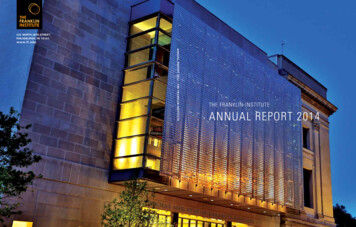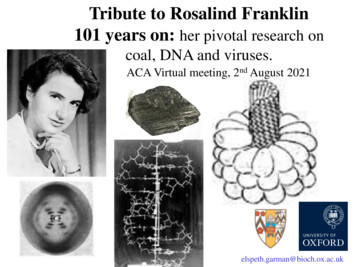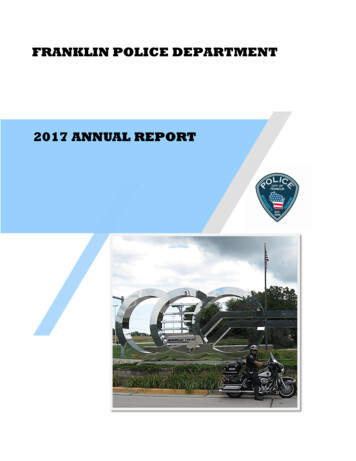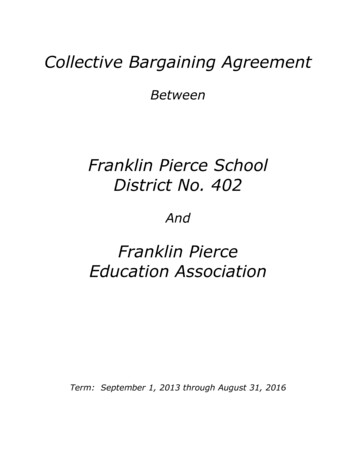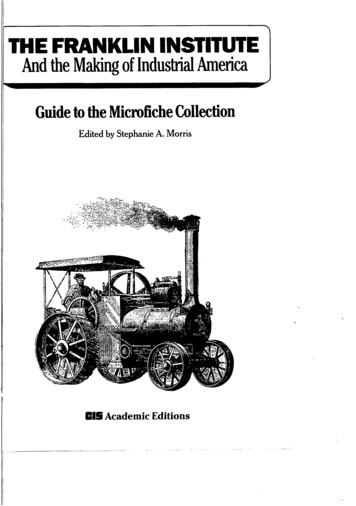
Transcription
THE FRANKLIN INSTITUTEAnd the Making of Industrial AmericaGuide to the Microfiche CollectionEdited by Stephanie A. MorrisCIS Academic Editions
THE FRANKLIN INSTITUTEAnd the Making of Industrial America
THE FRANKLIN INSTITUTEAnd the Making of Industrial AmericaGuide to the Microfiche CollectionEdited by Stephanie A. MorrisCIS Academic EditionsCongressional Information Service, Inc.Bethesda, Maryland
CIS StaffEditor-in-Chief, Special Collections August A. Imholtz, Jr.Project Editor John HeffemanStaff Assistant Monette BarreiroProduction Dorothy W. Rogers, Debra G. TurnellCommunications Richard K. JohnsonData Processing William DeRochePrinting Services Lee MayerCover Design Alberto InsuaMicrofilm Operations William IdolLibrary of Congress Cataloging in Publication DataCIS Academic Editions, Congressional Information Service, Inc.4520 East-West Highway, Bethesda, Maryland 20814 USA 1987 by Congressional Information Service, Inc. All rightsreserved.Printed in the United States of America
CONTENTSNOTE FROM THE PUBLISHERviiPREFACEixNOTE ON MICROFILMING PROCEDURESxiTHE DYNAMICS OF CHANGE: The Franklin Institute and theMaking of Industrial AmericaOverviewEducationEncouragement of InventionScientific InvestigationsAlexander Dallas BacheStandardizationExhibitionsChange and the InstituteBartol Research FoundationInstitute's New BuildingNotesList of PlatesPlates12334567991113BIBLIOGRAPHY OF DOCUMENTSManuscript MaterialsMembership Account BooksMinutes of MeetingsSections, 1869-1923Committee on InstructionSpecial CommitteesCorrespondenceExhibitionsBartol Research FoundationCommemorative Volumes151617212427304040
Iconographic MaterialsLecture Lantern SlidesWelsbach CollectionMidvale Steel Company CollectionFrederick Graff CollectionNaval ArchitectureWright Brothers Collection.INDEX TO NAMES OF INDIVIDUALS AND ORGANIZATIONS41434445516163
NOTE FROM THE PUBLISHERUnder a National Historical Publications and Records Commission (NHPRC) grantthe archivists and staff members of the Franklin Institute, who are acknowledgedby Stephanie A. Morris in her preface to this volume, selected from the Institute'sarchives historically representative manuscript and iconographic materialsdocumenting the Franklin Institute's important role in the making of industrialAmerica. The same NHPRC grant also supported both the writing of the findingaid, the final version of which was edited independent of NHPRC by CongressionalInformation Service, Inc. (CIS), and the production of the microfiche masters whichwere filmed in conformity to NHPRC technical standards by a firm other than CIS.CIS assumed responsibility for publishing the finding aid and manufacturing andmarketing distribution copies of the microfiche collection.However, in producing the microfiche collection for distribution and in verifying the finding aid descriptions, CIS discovered that some of the frames were verydifficult to read. Every effort has been made by CIS to identify any truly illegibleframes which escaped earlier scrutiny in the filming process and then to locate andto refilm those original documents which were capable of being refilmed. Therefilmed materials are included on the final 7 microfiche of the collection. An eyevisible asterisk before a frame indicates that frame has been refilmed. For eachitem that has been marked by an asterisk on the microfiche, a notation appears inthis finding aid under that microfiche number and frame reference referring the userto the appropriate microfiche number and frame reference for the refilmedmaterial.Further efforts have been made by CIS to enhance the image quality ofmicrofiche originally filmed from source documents varying greatly in quality.Many of the early nineteenth century materials, for example, were written invarious hands on paper differing considerably in the quality, color, and the care withwhich the paper documents were preserved. This is especially true of some of thecorrespondence and internal records. In a few instances in which the already filmeddocuments were judged to be too difficult to refilm satisfactorily, typewrittentranscripts of the documents were prepared by CIS and identified in the finding aidand on the microfiche in the same manner as the refilmed documents describedabove.In the finding aid, personal names have been indexed throughout when the individual is the author of a lecture or address appearing in the collection. Dates havegenerally been cited by month and year based on internal evidence in the document."Circa" has been used when external sources were the source for dating. In caseswhere no date could be established, "[nd]" was used. Wherever the narrative refersto documents in the fiche collection specific citations have been added. Annotationsof specific citations clarify the nature of the document or specific filming featureswhich could cause confusion, such as out-of-sequence items.
PREFACEThis microfiche collection and finding aid are the culmination of more than a decadeof work. Bruce Sinclair's original research into The Franklin Institute's history ledto an award-winning book and a National Science Foundation grant1. The NSFfunding resulted in the first microform edition--The Records of the Committee onScience and the Arts of The Franklin Institute 1824-19002 .A. Michal McMahon secured a National Endowment for the Humanities grantto catalogue other record groups in the historical collections. McMahon alsosecured the National Historical Publications and Records Commission grant whichfunded this, the second microform edition of archival records of The FranklinInstitute.A series of student interns and part-time assistants helped the full-time staff incataloguing and filming the records. A. Michal McMahon, Mark Rose, W. BernardCarlson and Diane Rosenwasser, the iconographic archivist, all worked to preparethe 536 microfiche for this edition. Filming and production of microfiche masterswere done by the James T. White and Co. of Princeton, New Jersey. The duplicatemicrofiche and this Guide are published by Congressional Information Service, Inc.,a leading publisher of indexes and microfiche collections for use by researchers andlibrarians.Gladys Breuer, curatorial assistant and keeper of the keys, has kept a watchfuleye on the diverse collections and personnel during all phases of this project.My thanks to all who helped in the past to make this present volume possible.STEPHANIE A. MORRISTemple UniversityPhiladelphia1. In 1975 the Society for the History of Technology awarded Bruce Sinclair the Dexter Prize for hisbook, Philadelphia's Philosopher Mechanics: A History of The Franklin Institute 1824-1865 (Baltimore:The Johns Hopkins University Press, 1974).2. Twenty-eight rolls of microfilm, A. Michal McMahon, editor; Stephanie A. Morris, assistant editor(Wilmington: Scholarly Resources Inc., 1977). See also McMahon and Morris, Technology in IndustrialAmerica: The Committee on Science and the Arts of The Franklin Institute 1824-1900 (Wilmington:Scholarly Resources, Inc., 1977), a calendar of the records.
NOTE ONMICROFILMING PROCEDURESThe National Historical Publications and Records Commission proposal specifiedthat a sampling of the Institute's textual and iconographic archival materials wouldbe placed on fiche. Editorial policies were made several years before this Guide waswritten, but the outlines are clear. Records of only "internal" interest (financial,building, etc.) were omitted but records of the Institute's involvement with thegrowing, modernizing technological community were selected for reproduction onmicrofiche. It was the responsibility of this author to write the Guide; selection andfilming of documents were supervised by earlier Institute staff. The Guide has beenedited by Congressional Information Service, Inc., of Bethesda, Maryland.Most of these records have never been published previously in any form in thetwentieth century. Portions of the John Lenthall Collection were reproduced inHoward I. Chapelle's History of the American Sailing Navy and portions of both theWright Brothers and Graff Collections have been on exhibit at the Franklin Instituteor have been reproduced for exhibit purposes.Of the records filmed, the items or series selected document significant aspectsof the Institute's structure and function. All relevant minute books were filmed. If aseries of correspondence contained substantive materials, then the entire series wasfilmed. In-Coming Correspondence, 1824-1859, shows the international range of theInstitute's contacts as well as the local involvement. In-Coming Correspondence(i.e. correspondence received by the Secretary or Actuary) after 1859 was notfilmed because it was generally routine; the more substantive correspondence during that period was addressed to specific committees and forms part of the recordsof those committees.The materials forming this microfiche edition are sufficient, if complementedby suitable secondary sources, to serve as the basis of any of a number of researchprojects. The individual introductions to the record groups describe some of theresearch potential of each record group filmed and any specific editorial policiesconcerning that group.The microfiche contain negative images for the manuscript materials. Theiconographic materials are black and white in order to retain as much contrast anddetails as possible.Because the filmed documents are of uneven sizes, different reduction ratioswere used as needed. The images are located by row and column designations.Each microfiche itself has a unique numerical descriptor. The horizontal rows beginat the top of the card, row A, and proceed downward, rows B, C, etc. Columns arecounted from the far left to the far right; the upper left-hand corner of fiche 330would be 330 A-l—fiche number 330, row A, column 1.
Pages of a periodical may have been double-shot, i.e. filmed two open pages atonce. In this case, page one would be A-l, page two would be A-2, etc. For the largepages of the 1884 and 1885 Bulletins, for example, one page does not fit on a normalviewer screen and one page is given one location designation. Thus for large sizeperiodicals or scrapbooks, page one is Al, page two is A2, etc.Eye-visible labels or targets were not counted in assigning locations. Thus although the words PORTRAIT GRAFF, SR., appear in the upper left-hand cornerof microfiche 372 (Graff Collection), followed by the image of Frederick Graff, Sr.,the actual portrait is given the location 372-A-2.Charles Wilt, Librarian of The Franklin Institute, and Thomas Whitehead,Head of Special Collections, Paley Library, Temple University, have been of inestimable assistance in helping me work in a new medium microfiche. I am gratefulalso to Allen F. Davis, Temple University, for an early reading of the introduction.They also helped to improve the Guide, any remaining lack of clarity is solely myresponsibility.
THE DYNAMICS OF CHANGE:THE FRANKLIN INSTITUTEAND THE MAKING OFINDUSTRIAL AMERICAOVERVIEWA group of industrialists and scientists met in 1824 in Philadelphia to form whatwould evolve into the most successful American representative of the mechanicsinstitute movement. Practical men such as Samuel Vaughan Merrick, an ironfounder, and academics like William H. Keating, the European-trained professor ofchemistry and mineralogy at the University of Pennsylvania, joined to form TheFranklin Institute for the Promotion of the Mechanic Arts. The Institute'smembers soon initiated a series of scientific investigations which brought the neworganization local and international recognition. Local papers reprinted the remarksof the editor of the London Mechanics' Magazine comparing The Franklin Institute's "extensive experiments" with the work expected of the newly formed BritishAssociation for the Advancement of Science1, A series of exhibitions of domesticmanufactures placed the finest examples of American products before theAmerican people. Through its monthly meetings and the Journal of The FranklinInstitute the scholarly community learned of the changing frontiers in the strengthof materials, standardization of weights and measures, and other areas of fundamental interest to scientific and technological progress.Professionalization of the national community of scientists and engineers overtook the pioneering private society by the last decades of the nineteenth century.Furthermore, the increase in the number of universities and industrial research programs and the specialization of the engineering professions would diminish theimpact of the comprehensive Institute. Through a series of modifications the Institute rose to meet the demands of sponsored research in the half-century followingthe first world war and to pioneer in popularizing scientific education.This Guide describes the documents selected for inclusion in the microfiche edition of The Franklin Institute and the Making of Industrial America (see Note onMicrofilming Procedures for an explanation of the selection procedures). Thematerials filmed illustrate the dynamic vigor of the young Institute, boldly initiating ascientific investigation into the causes of steam-boiler explosions and eagerly gathering a panorama of domestic products for display. Records in this collection alsoreflect the maturing Institute, working with the new specialized societies to promotefurther the beginnings of the electrical science and industry. The first series ofmodifications which changed the all-encompassing early Institute into a modernorganization is also part of this important history of American scientific and
technological growth. No organization with close ties to the academic, mechanic andengineering communities could survive for over a century and a half without experiencing some of the radical changes that the larger communities had undergone sincethe first quarter of the nineteenth century. This microfiche collection, finally,documents these changes as it reproduces portions of The Franklin Institute'shistory.Philadelphia in the 1820s was still a leading center of science and commerce. TheAmerican Philosophical Society, the Academy of Natural Sciences of Philadelphia,the University of Pennsylvania with its medical school, and other institutions of learning grew in an environment conducive to scientific endeavors and friendly to its practitioners. The Franklin Institute's membership had ties to these organizations.Samuel Vaughan Merrick's uncle, John Vaughan, was Treasurer of the AmericanPhilosophical Society in 1824. William H. Keating had studied at the University ofPennsylvania before continuing his studies in technical schools in France andSwitzerland. Other early Institute members strengthened and enhanced the Institute's links to Philadelphia's intellectual and cultural circles. Matthew Carey, vicepresident and chairman of the Board of Managers until 1826, was a publisher and hadbeen one of the founders of the Pennsylvania Society for the Promotion of InternalImprovements in 1824. Robert M. Patterson, holder of the Institute's chair of naturalphilosophy in 1824, held the same post at the University of Pennsylvania. Keating,holder of the chairs of chemistry and mineralogy at the Institute, held the same postsat the University of Pennsylvania. Both Patterson and Keating were also secretariesof the Philosophical Society in 18242.EDUCATIONEducation was an important early activity at The Franklin Institute, but a debateover the structure and function of the course of instruction interfered with the support such a school program required. Should the Institute offer free education forthe working class (as benevolent societies did), or a classical school during the dayfor the upper classes, or an English school with a blend of science and collegepreparatory classes? These same issues caused controversy at other institutionsacross the nation during the nineteenth century3.The Institute began by offering a classical high school education under thedirection of Walter R. Johnson, a Harvard College graduate and former principal ofthe Germantown Academy. This lasted for three years. Johnson then conducted hisown school in rooms rented from the Institute for another three years. In 1830 Alexander Dallas Bache, chairman of the Committee on Instructions, advocated achange in the school program. An English school was offered in the evenings underSeth Smith, a local teacher. By 1836 the Institute's involvement with secondaryeducation ended, due in part to the establishment of the Philadelphia public schoolsystem, and it focused its instructions in the areas of prime concern to the scientificand business communities--mathematics and mechanical drawing. These programswere never large but did enjoy moderate success. The courses of instruction underwent a variety of changes throughout the century; a course in stenography wasadded and the whole program was reorganized as the School of Mechanic Arts in1910. By the early twentieth century universities and agricultural schools, however,were offering advanced study in science and engineering. High schools began tooffer phonetic writing, including shorthand and stenography. Realizing that the
Institute was duplicating instruction offered elsewhere, in 1923 the Committee onInstruction closed the Institute's pioneering efforts in the fields of secondary andvocational education4.An adult education program was offered through evening lectures by Institutemembers such as Peter A. Browne, Robert M. Patterson, and William H. Keating.These often were published in the Journal of The Franklin Institute for widerdistribution. Later in the century the lectures were illustrated with lantern slides.Topics covered included a wide range from natural philosophy to street lighting,smoke nuisance from the burning of coal, municipal water supplies, and the newestadvances in almost every area of science (see the section of the Guide on LectureLantern Slides for a sample of lectures, and on the Minutes of Meetings for a list ofspeakers and topics).ENCOURAGEMENT OF INVENTIONThe Franklin Institute promoted the mechanic arts actively as well as passivelythrough the transmission of cumulated knowledge. The Board of Managersappointed a Committee on Inventions to advise and encourage inventors. Workingthrough subcommittees, these men examined and reported on inventions ortheories submitted to the Institute. In 1834 the committee was reorganized andexpanded to include other members than those on the Board of Managers. Theresolutions governing the new committee specified an "unlimited" number ofmembers who would enroll their names in the roll book. The Committee on Scienceand the Arts would examine "all inventions that may be submitted" making"detailed, descriptive reports thereon, giving their opinion with candor and impartiality. ." The reports would include an analysis of the invention in terms of itsusefulness and practicality, its simplicity and availability.5By mid-century the applications covered a wide range of inventiveness and soonincluded specialized industries. The Committee drew upon the diverse expertisewithin the Institute's membership and referred inventions submitted for examinationto specialized discussion groups called Sections, formed during the last quarter of thenineteenth century. Thus, electrical applications were referred to the Electrical Section and chemical compounds to the Chemical Section for report.6The Committee on Science and the Arts also awarded medals to inventors forparticularly excellent or ingenious inventions. Applications for these awardsincreased rapidly both in quantity and scope. Since no one group of volunteers couldcontinue to investigate every advance in "Science and the Arts", the Committee wasrestructured again, this time narrowing its activities to honoring the more exemplaryadvances in science, engineering, and business with a medal and certificate. Theseawards are still presented at the Institute's annual Medal Day.SCIENTIFIC INVESTIGATIONSParticular topics of concern to the budding technological communities came in forspecial investigation. In 1829, Samuel Vaughan Merrick proposed a series of testsof water wheels because the value of water as a prime mover and its effect on different kinds of wheels "has never been fixed by actual experiment on a scale of sufficient magnitude to settle principles upon which it is to be calculated"7. The Boardof Managers appointed Merrick, Benjamin Reeves (nail manufacturer), Isaiah
Lukens (machinist), Rufus Tyler (machinist), and Andrew Young to a committee todevise a series of experiments to determine these principles. The Committee issueda circular, on March 16, 1829, inviting drawings and papers from every "gentlemanconversant" with water wheels and soliciting subscriptions to underwrite the tests.Correspondence came from Brandywine, Lowell and Paterson; subscriptions camefrom E.I. duPont, from John Colt, agent of the Society for Establishing UsefulManufactures, and from Warren Colburn of the New England Society for the Promotion of Manufactures and the Mechanic Arts. (See records of the Committee onWater Wheels for circular and correspondence, and the section of the Guide onSpecial Committees-Committee on Water Wheels)To help plan and carry out the experiments, James P. Espy, chairman of the Institute's Committee on Meteorology (in 1831), Matthias Baldwin, the railroadmanufacturer, John Levering, John Agnes (partner in S.V. Merrick and Company),Samuel Haines, Frederick Graff of the Fairmount Water Works, Keating, and JamesRush (partner in Rush and Muhlenberg, who were builders of high pressure steamengines and some of the experimental equipment for the tests) were added to theCommittee. A structure was erected to house the equipment. Tests would determinethe time it took a measured amount of water to raise a given weight to a given height.A bell was rung as the valve opened and another as the weight was raised. Accuratetimepieces were used to measure the interval between the bells. Four different sizewheels were used and different bucket constructions were tested. Water was admitted from seven chutes in different positions. It was a sophisticated facility, designedto test all possible variables under conditions of the strictest accuracy8.The water wheels experiments were the Institute's first large scientific undertaking, a pioneering endeavor recognized internationally. While these tests were underway, William H. Keating suggested a second series of investigations. A new powersource attracted the interest of these men of science and business--steam boilers. Anumber of explosions, however, was creating fear and doubt concerning the safety(and wisdom) of steam boilers. Investigations were needed in order to ascertain thecauses of the explosions and hence a way to avoid them. A circular letter was issuedagain (reprinted in the Journal of The Franklin Institute, Vol. 10, pp. 35-37) and a committee was formed. This new committee designed the first machine to test thestrength of materials9. Walter R. Johnson, physicist and principal of the high school,chaired the subcommittee on the strength of materials. Keating was originally thechairman of the entire committee but had to withdraw. A new Institute member,Alexander Dallas Bache, nominated by Samuel Vaughan Merrick, was appointed tochair the committee. Alexander Dallas Bache, the greatgrandson of BenjaminFranklin and a West Point graduate and professor of natural philosophy andchemistry at the University of Pennsylvania, was named to fill this vacancy.ALEXANDER DALLAS BACHETwenty-three years old when he joined the Institute in 1829, Bache soon invigorated some of the most important committees10. He was elected to fill a vacancy onthe Board of Managers in 1830 and remained on the Board until he left for Europein 1837 and then served again from 1839 until he left for Washington, D.C. in 1843to become the superintendent of the U.S. Coast Survey. In 1836 he became the firstpresident of Girard College but a delay in the opening of the college prevented himfrom assuming that position. During the interval he toured Europe, purchasing
scientific equipment and books for Girard College11. Bache was on the Committeeon Inventions for three years and then chaired its successor, the Committee onScience and the Arts, for another three years. He chaired the Committee onInstructions for seven years and the Committee on Publications for four of hiseleven-year appointment to it. He was the first chairman of the monthly conversation meetings and was involved with the committee for five more years. In additionto these appointments (and his teaching duties), Bache served on special committees, being a late addition to the waterpower committee and succeeding Keating aschairman of the steam boiler committee. The tests of this last group were carefullyconducted and the detailed reports compiled were marked by a careful applicationof scientific research methodology to a critical problem in an industrializing society.Bache, and young men like him with academic training in science, fostered astreamlining of the Institute and focused its activities on the areas of science,technical research, and professional education. The Institute's English school, asnoted above, dates from Bache's appointment to the Committee on Instruction.Layton describes the role of the new technologist in replacing the artisan in thevanguard of technological progress. During his "Philadelphia period," Bache waspart of this new breed, working to promote applied science. During his laterWashington years, Bache acted as a "self-appointed leader of the scientific establishment." Nathan Reingold describes Bache as promoting the cause of research and theadvancement of scientific knowledge. Bache was one of the bridges, connecting the"mirror-image twins" of science and technology in the nineteenth century12.In addition to Bache's many well-earned laurels as scientist, educator, and administrator, one other distinction deserves to be mentioned. Bache and other Managersmade history in advancing the cause of equality for women by electing the firstwoman member of The Franklin Institute. Edward Poole, exhibition judge (1825) andschool teacher, nominated Mrs. Elizabeth Skinner for membership in 1833. The actuary, William Hamilton, had to write "The persons nominated for membership."instead of his usual "The gentlemen." In December the "gentlemen proposed"the previous month were duly and quickly elected. The Messrs. Merrick and Fraley(Frederick Fraley--a boyhood friend of Bache and an Institute officer) moved thatMrs. Skinner be elected a member when, the minutes discreetly note, "a considerablediscussion" took place. A roll call vote was taken and she was elected by a ten to fivevote. Mrs. Skinner remained a member for only two years13.STANDARDIZATIONWater wheels and steam boilers were not the only areas of industrialization to bestudied by ad hoc committees of scientists, engineers, and businessmen. As an unofficial advisor to the government, The Franklin Institute recommended amendmentsto a Pennsylvania bill on standards for weights and measures in 1837 and presented asimilar report to Congress in 1902. These reports recommended adoption of themetric system; in the latter year the committee's report was adopted, but notunanimously, within the Institute. The topic generated considerable debate in thescientific and commercial communities at large as can be seen in the Report on MetricSystem, 1902, in this collection (Microfiche No. 142). Standards for screw threadswere presented by William Sellers, President of The Franklin Institute in 1864. Hispaper on screw threads became widely known and many organizations adopted thesystem of designs which became known as The William Sellers' or Franklin Institutesystem14. In 1878 the Committee on Instruction was authorized to purchase a
dynamo-electric machine for educational purposes. To determine the one best suitedto meet its need, the Institute appointed a committee to conduct a series of. comparative tests. Elihu Thomson and Edwin J. Houston, faculty members at CentralHigh School and partners in 1878 in the Thomson-Houston Company, conducted theelectrical tests. Both these men later served on similar subcommittees to conducttests during the 1884 International Electrical Exhibition15.All of these tests were conducted very carefully and with precisemeasurements. The subcommittees prepared statistical analyses of the results.Debates over the relative merits of the systems of weights and measures containreferences to manufacturing specifications and national prejudices. There were professional discussions in the rarified air of the academically oriented and in thespecialized aura of the machine shops. Was the general public totally ignored inthese debates over the future direction and course of American technologicaldevelopment? Certainly not, for the Institute's leadership clearly recognized thegeneral public as an important part of the technological community for they (thepublic) were the consumers.EXHIBITIONSFour elements are essential for technological development: accumulatedknowledge, evident need, economic possibility, and cultural and social acceptability16. The manufacturers of goods hoped to increase the social acceptability ofAmerican-made goods (over imported ones) by demonstrating the equality ofAmerican and European products. What good was a better mousetrap (or strawbonnet or structural steel) if people bought out of habit and didn't even try itemsmanufactured by local sources?The Franklin Institute recognized the need for "consumer education." Browndescribes the general stores of the mid-nineteenth century as pioneers in "consumer education" because the stores permitted customers to inspect goods eventhough they did not intend to purchase these items immediately17. Exhibitions ofdomestic ma
2. Twenty-eight rolls of microfilm, A. Michal McMahon, editor; Stephanie A. Morris, assistant editor (Wilmington: Scholarly Resources Inc., 1977). See also McMahon and Morris, Technology in Industrial America: The Committee on Science and the Arts of The Franklin Institute 1824-1900 (Wilmington:





